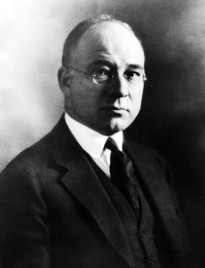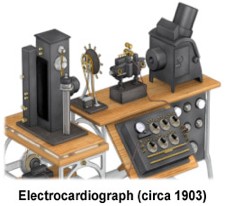The First Electrocardiograph in the United States

Cohn, Alfred
Courtesy of the Rockefeller Archive Center
The electrocardiograph—what we now call an ECG or EKG—measures the small electrical currents generated by the heart as it beats. Willem Einthoven, a Dutch physiologist, invented the first version of the instrument, called a string galvanometer, in 1901. Within a decade, improved commercial models were available to researchers and clinicians. In 1909, Alfred E. Cohn (1879-1957) brought one of these devices from London to New York—the first electrocardiograph in the United States.
In studies at the Rockefeller Hospital, Cohn developed the use of the electrocardiograph to characterize the functioning of the heart in human diseases such as pneumonia and rheumatic fever. His research also contributed to the basic understanding of electrical patterns produced by the heart, the anatomy of the heart, and the diagnosis of disease.

Courtesy of Florida State University
Alfred E. Cohn, one of the first cardiologists in the United States, was born in New York City and received the MD from the College of Physicians and Surgeons at Columbia University in 1904. Between 1907 and 1909 he studied in Freiburg, Vienna, and London. When he returned to the United States, Cohn joined the staff of Mount Sinai Hospital in New York. In 1911 he moved to the Rockefeller Hospital, bringing his electrocardiograph with him. He remained at Rockefeller for the rest of his career, retiring in 1944. Cohn took a leading role in organizations such as the New York Heart Association, New York Academy of Medicine, Veterans Administration, China Medical Board, Asia Institute, Sydenham Hospital, and the Committee for Displaced Foreign Scholars and Displaced Foreign Physicians. Cohn also published books of essays dealing with the philosophy of medicine and its role in society.
Selected Publications
Cohn AE. Auricular tachycardia with a consideration of certain differences between the two vagi. J Exp Med, 1912, 15: 49-62
http://jem.rupress.org/cgi/reprint/15/1/49
Cohn AE, Fraser FR, and Jamieson RA. The influence of digitalis on the
T wave of the human electrocardiogram. J Exp Med, 1915, 21: 593-603
http://jem.rupress.org/cgi/reprint/21/6/593
Cohn AE and and Jamieson RA. The action of digitalis in pneumonia. J Exp Med, 1917, 25: 65-81
http://jem.rupress.org/cgi/reprint/25/1/65
Cohn AE and Swift HF. Electrocardiographic evidence of myocardial involvement in rheumatic fever. J Exp Med, 1924, 39: 1-36
http://jem.rupress.org/cgi/reprint/39/1/1
Further Reading
Burch and DePasquale, A History of Electrocardiography (Year Book Medical Publishers, 1964)
Cohn AE. Medicine, Science, and Art: Studies in Interrelations, 1931, Kessinger Publishing, LLC, 2003
Cohn AE. Minerva's Progress:Tradition and Dissent in American Culture, 1946
Cohn AE. No Retreat From Reason and Other Essays, 1948
